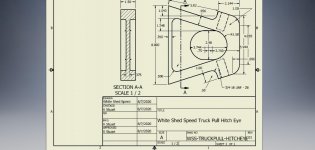bastarddsm
Aluminum
- Joined
- Feb 18, 2014
- Location
- Southern Illinois University
I'm sure this is pretty trivial to many of you, but, I have a few parts to make out of what I assume is A36 structural steel. These are hitch parts for tractor pulling. The customer has supplied a 1.5"x8"x36" bar of hot rolled steel, that I assume is A36, and I need to make 4 of these out of it. I'm just starting with this stuff, and have a pretty good handle on running aluminum but not steel.
I have a Tree VMC 1060,(16klbs, 40 taper, box way, 20hp, 40x24 for those who don't know) and it's on a 15hp rpc, so I don't have all the spindle power available. I have 2 china 6" vices. I don't have much budget for tooling at this time. I bought a couple 3/4" 6 flute carbide endmills, and a few 1/2" ones as well. I
What's the best plan of attack? Minimal tooling expense is favored over quickness, I don't have a lot of other work to do on the machine right now. I also have tons of other stuff to do while this is cutting, so it needs to not need babysat.
My plan was saw cut the bar into blocks just a bit over 8". Put the jaws on the outside of the vice, and set them on the vice, grabbing the saw cuts and square up the as rolled sides so I have something to locate off. After that turn them 90* and square up the saw cut on one side. Then profile it down to a little over half depth. Probably use a drill to start the hole, then endmill to carve the pocket down to a little over half depth. Flip it over, then start the profile and pocket routine over. I planned on making a negative of the part I could bolt on a 90* angle plate to hold it to drill and then thread mill the bolt holes.
I have no idea on depth of cut and speed. Only steel I've cut has been on a bridgeport, and it was slow and suck, so I have no idea what to do on a real machine. I planned on running the 3/4 6 flute since it's the biggest thing I have that will fit in the corners and and it has the right corner radius. How deep and how fast should I be running it? Should I be using a different tool? Should I use coolant, it has flood and has QC 215C in the machine.

I have a Tree VMC 1060,(16klbs, 40 taper, box way, 20hp, 40x24 for those who don't know) and it's on a 15hp rpc, so I don't have all the spindle power available. I have 2 china 6" vices. I don't have much budget for tooling at this time. I bought a couple 3/4" 6 flute carbide endmills, and a few 1/2" ones as well. I
What's the best plan of attack? Minimal tooling expense is favored over quickness, I don't have a lot of other work to do on the machine right now. I also have tons of other stuff to do while this is cutting, so it needs to not need babysat.
My plan was saw cut the bar into blocks just a bit over 8". Put the jaws on the outside of the vice, and set them on the vice, grabbing the saw cuts and square up the as rolled sides so I have something to locate off. After that turn them 90* and square up the saw cut on one side. Then profile it down to a little over half depth. Probably use a drill to start the hole, then endmill to carve the pocket down to a little over half depth. Flip it over, then start the profile and pocket routine over. I planned on making a negative of the part I could bolt on a 90* angle plate to hold it to drill and then thread mill the bolt holes.
I have no idea on depth of cut and speed. Only steel I've cut has been on a bridgeport, and it was slow and suck, so I have no idea what to do on a real machine. I planned on running the 3/4 6 flute since it's the biggest thing I have that will fit in the corners and and it has the right corner radius. How deep and how fast should I be running it? Should I be using a different tool? Should I use coolant, it has flood and has QC 215C in the machine.



 ]
]